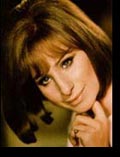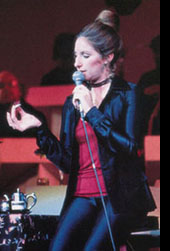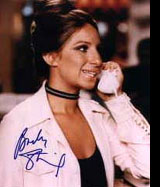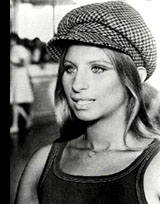|
Click here to listen to midi file of
"People" from "Funny Girl" as you surf.
 When 1970 began, Barbra was caught in something of a dilemma. She was on the one hand acknowledged a superstar who had two movies out, but on the other, she was famous for a genre that had dropped out of sight - the Hollywood musical. She was in danger of becoming obsolete before she was 30 because she could not connect with a younger, hipper audience.
When 1970 began, Barbra was caught in something of a dilemma. She was on the one hand acknowledged a superstar who had two movies out, but on the other, she was famous for a genre that had dropped out of sight - the Hollywood musical. She was in danger of becoming obsolete before she was 30 because she could not connect with a younger, hipper audience.
"On A Clear Day You Can See Forever" opened in June 1970 with little fanfare. The wilting Hello, Dolly! Had convinced the studios that the old-fashioned Broadway musical was dead. However, because of the film's modest budget, Forever did not lose money.
 Barbra was determined to shed her behind-the-times image when she put together her next album. She recorded songs by some of the best contemporary songwriters, including Joni Mitchell and Randy Newman, and most notable sang Laura Nyro's composition "Stoney End, Stoney End," which had previously been recorded by various other artists. Clive Davis, Columbia Records president, believed he had a hit, and was right when the song reached no. 6 in the charts. Columbia then released an album of the same name, which won Streisand terrific reviews and landed in the top 10 of Billboard's charts. Barbra was once again contemporary and enormously succesful.
The Owl and the Pussycat opened in November 1970, receiving good reviews, becoming one of the most succesful movies of the year. Barbra was again playing Las Vegas at the end of 1970, at the Riviera and then the Hilton. One year later, she again performed in Vegas at the Hilton. It would be her last performance for the general public for 15 years.
Barbra was determined to shed her behind-the-times image when she put together her next album. She recorded songs by some of the best contemporary songwriters, including Joni Mitchell and Randy Newman, and most notable sang Laura Nyro's composition "Stoney End, Stoney End," which had previously been recorded by various other artists. Clive Davis, Columbia Records president, believed he had a hit, and was right when the song reached no. 6 in the charts. Columbia then released an album of the same name, which won Streisand terrific reviews and landed in the top 10 of Billboard's charts. Barbra was once again contemporary and enormously succesful.
The Owl and the Pussycat opened in November 1970, receiving good reviews, becoming one of the most succesful movies of the year. Barbra was again playing Las Vegas at the end of 1970, at the Riviera and then the Hilton. One year later, she again performed in Vegas at the Hilton. It would be her last performance for the general public for 15 years.
Meanwhile, Elliot Gould was going insane. His use of drugs was undermining his career and his erratic behaviour on the set of "A Glimpse of Tiger" caused the studio to shut down production and sue the actor. The studio put together a file with details of Gould's erratic behaviour for a group of psychiatrists, who pronounced him insane. Concerned about Gould's welfare, Barbra approached Warner Bros. And asked if she could do anything to prevent the studio from suing the actor. They suggested that she star in the aborted production, with the starring role rewritten for a woman. Barbra agreed, providing that she starred opposite her new boyfriend, Ryan O'Neal.

 The studio assented, but there was one problem. Bogdanovich did not want to do "A Glimpse of Tiger".
He wanted to do an old-fashioned comedy like they used to in the thirties and forties. On August 16, 1971,
Barbra began work on her next film, "What's Up, Doc?", but with trepidation. Despite director Peter Bogdanovich's
success with "The Last Picture Show" and a script by David Newman and Robert Benton, whose last effort, "Bonnie
and Clyde", was nominated for an Academy Award, Barbra was convinced she was making a bomb. Bogdanovich tried
to reassure Barbra, asking him to trust him that it would play funny. So she did. Bogdanovich was very much a controlling
personality. "She tried to direct me, but we put a stop to that real quick," he later said. The fast pace of the film and slapstick
elements took its toll and O'Neal suffered a serious back injury during the shooting of the climatic chase scene.
By the end of production, Barbra and Ryan had spilt up, largely because Ryan was having a fling
with Peggy Lipton. Barbra was soon seen on the social scene with superstar actor Steve McQueen.
Yet Barbra still had a soft spot in her heart for O'Neal and went to visit him in hospital after he had surgery
to remove two disks from his spine.
Barbra was so convinced that "What's Up, Doc?" was going to be a flop that she sold her share in the film back to the studio. "I was embarassed to do that fim," she said. "It was a disappointing experience." For one of the few times in her life, she was wrong about one of her pictures. When "What's Up, Doc?" was released in March, it drew rave reviews and grossed more than $50 million at the box office.
The studio assented, but there was one problem. Bogdanovich did not want to do "A Glimpse of Tiger".
He wanted to do an old-fashioned comedy like they used to in the thirties and forties. On August 16, 1971,
Barbra began work on her next film, "What's Up, Doc?", but with trepidation. Despite director Peter Bogdanovich's
success with "The Last Picture Show" and a script by David Newman and Robert Benton, whose last effort, "Bonnie
and Clyde", was nominated for an Academy Award, Barbra was convinced she was making a bomb. Bogdanovich tried
to reassure Barbra, asking him to trust him that it would play funny. So she did. Bogdanovich was very much a controlling
personality. "She tried to direct me, but we put a stop to that real quick," he later said. The fast pace of the film and slapstick
elements took its toll and O'Neal suffered a serious back injury during the shooting of the climatic chase scene.
By the end of production, Barbra and Ryan had spilt up, largely because Ryan was having a fling
with Peggy Lipton. Barbra was soon seen on the social scene with superstar actor Steve McQueen.
Yet Barbra still had a soft spot in her heart for O'Neal and went to visit him in hospital after he had surgery
to remove two disks from his spine.
Barbra was so convinced that "What's Up, Doc?" was going to be a flop that she sold her share in the film back to the studio. "I was embarassed to do that fim," she said. "It was a disappointing experience." For one of the few times in her life, she was wrong about one of her pictures. When "What's Up, Doc?" was released in March, it drew rave reviews and grossed more than $50 million at the box office.
Text above is adapted from the following books. Sincere appreciation and thanks.
Her Name Is Barbra -
by Randall Riese.
Streisand: the intimate biography -
by James Spada.
Streisand: the pictorial biography -
by D.Harvey and J.Harvey.
Midi file from the On A Clear Day
Jukebox.


|

